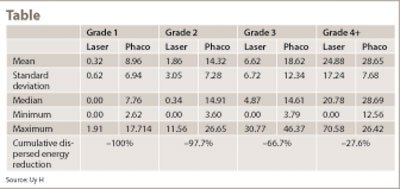Femtosecond laser system useful in lens fragmentation of +3 and +4 cataracts
The system also creates a perfect capsulorrhexis.
 Harvey Uy |
In my corner of the world, we are lucky to have spectacular beaches and plenty of sunshine. But this tropical, sunny climate also produces some of the most dense, brunescent cataracts in the world. With this in mind, when we began working with the LensAR femtosecond system for cataract surgery, a big question was whether the laser had the ability to emulsify hard +3 and +4 nuclear cataracts.
Having applied the LensAR laser femtosecond system on more than 250 eyes, we can report that the system is capable of fragmenting +3 and +4 cataracts. Our results to date were reported during a discussion group that took place at the World Ophthalmology Congress in Berlin. The participants in the discussion session included Thomas Neuhann, MD, Munich, Germany; Thomas Kohnen, MD, Frankfurt, Germany; Joseph Colin, MD, Bordeaux, France; Emmanuel Rosen, FCOphth, Manchester, UK; Michael O’Keeffe, MD, Dublin, Ireland; and Jean-Luc Febbraro, MD, Paris; as well as my co-investigators on the LensAR system: William Fishkind, MD, Tucson, Ariz., and Ronald Krueger, MD, Cleveland.
The approach
As I explained during the session, before we began working with the prototype of the LensAR laser system, we were using the Infiniti system (Alcon) and the stop-and-chop technique for nuclear disassembly. With the LensAR laser, we now perform a procedure in which the laser creates a perfect capsulorrhexis, followed by laser lens fragmentation-assisted pre-chopping to break the nucleus down into small pieces, making it much easier to emulsify the lens and aspirate the lens fragments from the capsular bag.
We started our LensAR clinical study in December 2009, and we have exited our first patients who have completed the 6-month follow-up period. We have treated more than 250 eyes using the LensAR system and observed that the laser is effective at breaking down dense, brunescent +3 and +4 cataracts. And after laser lens fragmentation, we find that the lens fragments can easily be removed with minimal, and sometimes no, phaco energy. From a clinical standpoint, our results show a mean reduction in phaco energy of 66.7% in +3 cataracts and 27.6% in +4 cataracts (Table).
 |
We have found that the LensAR laser system leads to better surgical efficiency because it facilitates the key steps in the cataract surgery procedure: capsulorrhexis and lens fragmentation. Regarding capsulorrhexis, after performing the measurement with the proprietary scanning and measurement system in order to image the lens, you can position the capsulorrhexis so that it is perfectly centered. You can also set the size of the capsulorrhexis based on the pupil size of the patient or the desired size for a particular IOL. Regarding lens fragmentation, the LensAR system fragments or chops up the lens into small, bite-sized pieces. For divide-and-conquer surgeons, less phaco energy is needed to emulsify the laser-fragmented nuclear pieces. For surgeons who employ chopping techniques (eg, pre-chop, phaco chop, stop-and-chop), the LensAR system creates grooves within the lens nucleus that act as fracture lines, making it easy to chop the nucleus.
We also believe that this approach enhances surgical safety because it reduces the occurrence of capsular tears and irregularly shaped, off-centered capsulorrhexes. The laser system is particularly useful in the presence of anterior capsular fibrosis, which may cause the capsulorrhexis to become irregularly shaped or may lead to capsular tears. The laser system overcomes this problem by cleanly cutting through the areas of fibrosis. By reducing the amount of phaco energy during lens fragmentation, the laser system can decrease the amount of surgical trauma to the corneal endothelial cells and reduce the incidence and amount of corneal edema. Lastly, we utilize the highly precise LensAR 3D CSI imaging system to visualize the cataract and create a thin epinuclear plate just anterior to the cortex. This extra nuclear plate provides an additional protective layer for the posterior capsule and can easily be aspirated out after removal of the nucleus.
One of the questions that came up during the discussion group was the effectiveness of the LensAR system on white cataracts, which, as we know, can be challenging even with current advanced phaco technology. For white cataracts, we are using the LensAR system to construct the capsulorrhexis, and this works well, as white cataracts are frequently associated with capsular fibrosis. We are able to fashion the opening without trypan blue. However, the white-colored nucleus reflects the femtosecond laser light, so the laser is able to penetrate only the superficial, anterior part of the lens, which may not assist significantly in breaking up the lens nucleus.
As I explained at the World Ophthalmology Congress, with the large LensAR laser prototype, the femtosecond treatment is performed in one room while removal of the fragmented lens, irrigation and aspiration, and IOL placement are performed in another surgical suite. When the compact LensAR system becomes commercially available, the more ergonomic commercial unit should easily fit in a standard operating room together with the phaco machine and operating microscope.
Our experience to date on +3 and +4 cataracts has been positive. We have found that the LensAR system is quickly becoming an essential tool for us in the two most crucial steps of the surgery: capsulorrhexis and lens fragmentation. At the same time, this laser system increases safety for the challenging cataracts that we face. I believe femtosecond cataract surgery will greatly enhance surgical efficiency and safety for all cataract surgeons.

- Harvey Uy, MD, can be reached at the Asian Eye Institute, Makati City, Philippines; email: harveyuy@yahoo.com.
- Disclosure: Dr. Uy is a paid principal investigator for LensAR and a consultant and advisory board member for Alcon Surgical.
